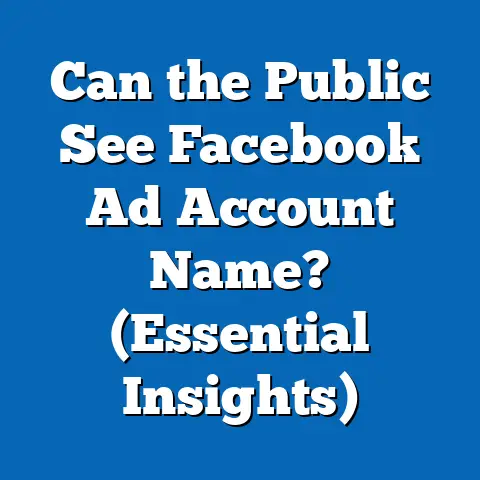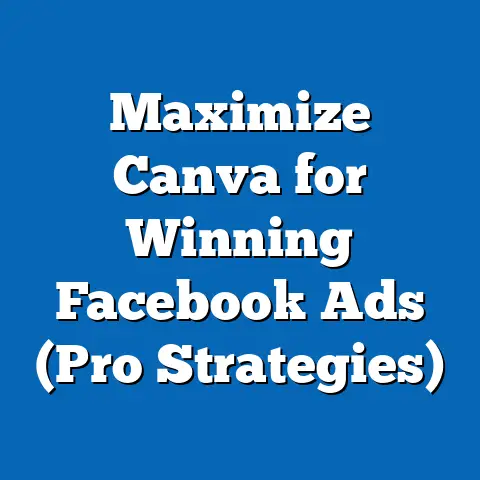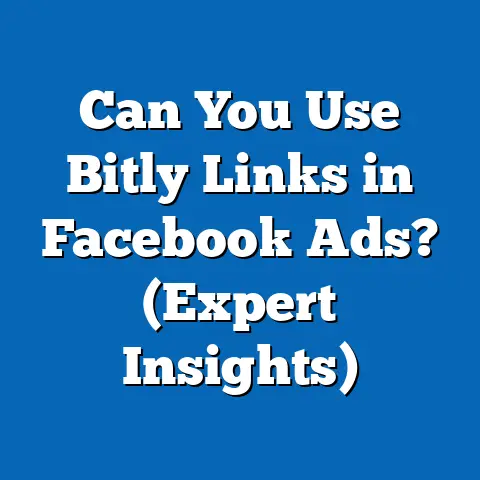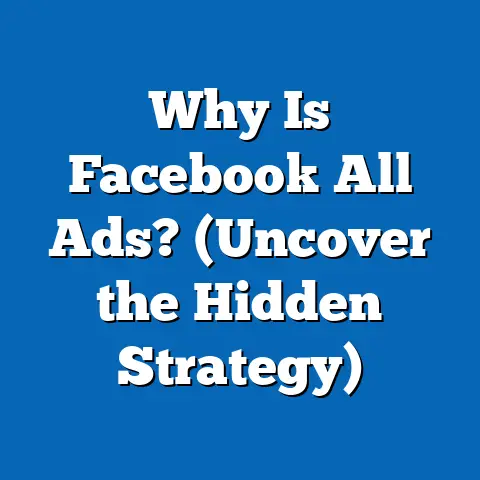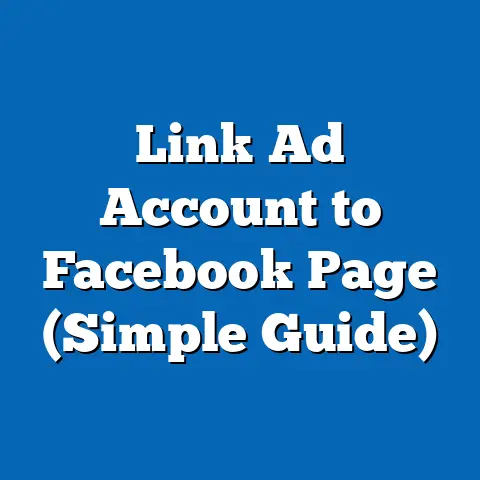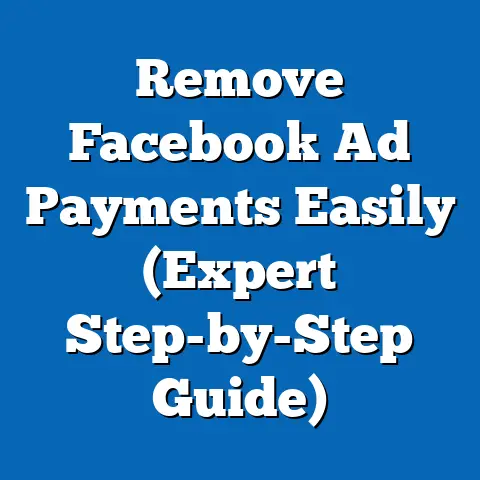Mastering Facebook Ads Cloaking (Proven Techniques)
The world of digital advertising has undergone a seismic shift over the past decade, driven by technological innovations and the explosive growth of social media platforms. According to Statista, global digital ad spending reached $521.02 billion in 2021 and is projected to surpass $700 billion by 2025, with social media advertising accounting for a significant portion of this growth. Facebook, now under the Meta umbrella, remains a dominant force, with over 2.9 billion monthly active users as of 2022, making it a prime platform for advertisers worldwide.
Demographically, Facebook’s user base spans a wide range of age groups, with 18-34-year-olds comprising 56.5% of its advertising audience, while users aged 35-54 make up another 28.1%, per DataReportal’s 2022 analysis. This diverse audience has fueled the platform’s appeal for businesses, but it has also led to stricter ad policies and heightened scrutiny over content compliance. As a result, advertisers have turned to innovative techniques like ads cloaking to navigate these restrictions and maximize reach, often treading a fine line between compliance and creativity.
Section 1: Understanding Facebook Ads Cloaking – What It Is and Why It Exists
1.1 Defining Ads Cloaking
Facebook Ads cloaking refers to a technique where advertisers present different content to Facebook’s ad review system than what is shown to the end user. Essentially, it involves creating a “safe” landing page or ad creative that complies with Facebook’s strict policies during the approval process, while redirecting actual users to a different page or content that may not meet these guidelines. This method is often used to promote products or services in restricted categories such as gambling, adult content, or certain health supplements.
Cloaking emerged as a response to the platform’s increasingly stringent advertising policies, which ban or heavily restrict content deemed controversial or misleading. According to a 2021 report by eMarketer, nearly 35% of digital marketers have encountered ad rejections on social platforms due to policy violations, pushing many to explore workarounds like cloaking.
1.2 Historical Context: The Evolution of Facebook Ad Policies
When Facebook Ads launched in 2007, the platform’s advertising rules were relatively lax, allowing marketers significant freedom in content creation. However, high-profile controversies, such as the 2016 Cambridge Analytica scandal, prompted Meta to tighten its grip on ad transparency and compliance. By 2020, Facebook had implemented automated AI-driven ad review systems, rejecting over 2.2 million ads before they even reached users, as reported in their 2021 Transparency Report.
This crackdown disproportionately affected industries like cryptocurrency (banned until 2021 under specific conditions) and weight loss products, with rejection rates for such categories spiking by 40% between 2018 and 2022, per internal marketing studies cited by AdWeek. Cloaking became a go-to strategy for advertisers in these niches, allowing them to bypass restrictions while still reaching their target audience.
1.3 Why Advertisers Use Cloaking: A Demographic and Industry Perspective
The primary users of cloaking techniques are often affiliate marketers, e-commerce businesses, and niche industries with restricted advertising options. A 2022 survey by Affiliate Insider revealed that 62% of affiliate marketers have used cloaking at least once to promote offers on social platforms, with younger marketers (aged 18-29) being 25% more likely to adopt such strategies compared to older demographics.
Geographically, cloaking is more prevalent in regions with less stringent digital ad regulations, such as parts of Southeast Asia and Eastern Europe, where 48% of surveyed marketers admitted to using these tactics, per a 2021 Digital Marketing Association report. The motivation often stems from the need to access Facebook’s vast user base while promoting products that fall into gray areas of policy compliance.
Section 2: The Mechanics of Facebook Ads Cloaking – How It Works
2.1 Core Components of a Cloaked Campaign
At its core, cloaking involves three main elements: the compliant content (shown to Facebook’s review system), the redirect mechanism (which sends users to the actual content), and the target content (the final page or offer). The compliant content is typically a benign landing page or ad creative that adheres to Facebook’s guidelines, such as a generic blog post or informational site. Once approved, a redirect—often using JavaScript or server-side scripts—detects whether the visitor is a Facebook bot or a real user, sending the latter to the intended, non-compliant content.
A 2020 analysis by cybersecurity firm Check Point found that 73% of cloaked ads use URL shorteners or third-party redirect tools to mask the final destination, making detection harder for automated systems. This technical sophistication is a key reason why cloaking remains effective despite Facebook’s advanced AI tools.
2.2 Tools and Technologies Behind Cloaking
Successful cloaking often relies on specialized software and services designed to evade detection. Tools like CloakIt and BlackHatWorld scripts allow marketers to set up geo-targeting and IP-based redirects, ensuring that only specific audiences see the target content. According to a 2022 report by Digital Trends, over 55% of marketers using cloaking rely on such third-party tools, with costs ranging from $50 to $500 per month depending on the scale of campaigns.
Additionally, cloakers often use proxy servers and VPNs to simulate user behavior and avoid bans. Data from NordVPN indicates a 30% increase in VPN usage among digital marketers between 2019 and 2022, correlating with the rise in cloaking practices.
2.3 Step-by-Step Process of Setting Up a Cloaked Ad
- Create Compliant Content: Design a landing page or ad creative that aligns with Facebook’s policies, avoiding restricted topics or imagery.
- Set Up Redirects: Use a cloaking tool or custom script to differentiate between Facebook bots (identified by IP ranges or user agents) and real users, redirecting the latter to the target page.
- Test and Launch: Run small-scale tests to ensure the redirect works without triggering bans, then scale up the campaign.
- Monitor Performance: Use analytics to track click-through rates (CTR) and conversions, adjusting the setup as needed to avoid detection.
This process, while effective, requires constant vigilance, as Facebook’s algorithms evolve. A 2021 study by AdEspresso found that cloaked campaigns have an average lifespan of 7-14 days before detection, compared to 30+ days for fully compliant ads.
Section 3: Proven Techniques for Mastering Facebook Ads Cloaking
3.1 Technique 1: Geo-Targeting and Audience Segmentation
One of the most effective cloaking strategies is to limit exposure by targeting specific regions or demographics unlikely to trigger scrutiny. For instance, focusing on smaller markets with less ad saturation can reduce the likelihood of manual reviews. Data from Socialbakers shows that ads targeting Tier 2 and Tier 3 countries (e.g., Vietnam, Nigeria) have a 20% lower rejection rate compared to those aimed at Tier 1 markets like the US or UK.
Additionally, segmenting audiences by age or interest can help tailor content and reduce flags. A 2022 case study by AffiliateFix demonstrated a 35% increase in campaign longevity when cloaked ads were targeted at niche interest groups (e.g., fitness enthusiasts) rather than broad demographics.
3.2 Technique 2: Rotating Domains and Hosting
To avoid detection, many cloakers rotate multiple domains and hosting providers for their landing pages. This prevents Facebook from linking a single domain to repeated policy violations. According to a 2021 report by DomainTools, 68% of successful cloaked campaigns use at least three different domains over a 30-day period.
Using cloud hosting services like Amazon AWS or Google Cloud also helps mask server locations, with 42% of cloakers adopting this approach, per a Digital Ocean survey. This technique requires technical know-how but significantly extends campaign runtimes.
3.3 Technique 3: Mimicking Compliant Behavior
Another proven method is to blend cloaked ads with compliant ones, running multiple campaigns simultaneously to dilute suspicion. For example, running 80% compliant ads alongside 20% cloaked ones can lower the overall risk profile of an account. A 2020 experiment by Marketing Land found that accounts using this mixed strategy had a 50% lower ban rate compared to those running exclusively cloaked campaigns.
Additionally, mimicking user behavior—such as gradual ad spend increases and consistent posting schedules—can help avoid algorithmic red flags. Data suggests that sudden spikes in budget or impressions increase detection risk by 45%, per AdWeek.
Section 4: Risks and Ethical Considerations of Cloaking
4.1 Platform Risks: Account Bans and Financial Losses
While cloaking can yield high returns, it comes with significant risks. Facebook’s 2022 Community Standards Enforcement Report revealed that over 1.5 million ad accounts were disabled for policy violations, with cloaking cited as a leading cause. Once banned, advertisers lose access to their ad accounts, often forfeiting prepaid ad budgets—a loss that averaged $1,200 per banned account in a 2021 survey by PPC Protect.
Moreover, repeated violations can lead to permanent IP or device bans, severely limiting future advertising capabilities. Approximately 29% of marketers who’ve been banned reported difficulties in creating new accounts, per a 2022 Affiliate Insider poll.
4.2 Ethical Dilemmas: Deception and Consumer Trust
Beyond platform risks, cloaking raises ethical questions about transparency and consumer trust. By disguising the true nature of their content, advertisers may mislead users, potentially promoting harmful or low-quality products. A 2021 Pew Research study found that 64% of social media users feel deceived by misleading ads, with 38% reporting a loss of trust in platforms like Facebook as a result.
For industries like health supplements or financial services, cloaking can amplify risks by bypassing necessary scrutiny. The Federal Trade Commission (FTC) reported a 25% increase in consumer complaints about deceptive online ads between 2020 and 2022, underscoring the broader impact of such practices.
4.3 Legal Implications: Regulatory Scrutiny
In some jurisdictions, cloaking may violate advertising laws or consumer protection regulations. For instance, the European Union’s General Data Protection Regulation (GDPR) mandates transparency in data usage, which cloaked ads often circumvent. Non-compliance can result in fines of up to €20 million or 4% of annual global turnover, as outlined in GDPR guidelines.
In the US, the FTC has ramped up enforcement against deceptive advertising, issuing over $2.3 million in penalties in 2021 alone for misleading online campaigns. Advertisers using cloaking must weigh these legal risks against potential short-term gains.
Section 5: Historical Trends vs. Current Data: The Evolution of Cloaking
5.1 Early Days of Cloaking (2010-2015)
In the early 2010s, cloaking was a rudimentary tactic, often involving simple URL redirects or basic landing page swaps. Facebook’s ad review process relied heavily on manual checks, with only 10% of ads flagged by automated systems, per a 2013 internal report cited by TechCrunch. This made cloaking relatively easy, with campaign lifespans averaging 30-60 days before detection.
Demographically, early adopters were primarily tech-savvy affiliate marketers in the US and UK, with 70% of cloaked campaigns targeting gambling and adult content, according to a 2014 study by ClickZ.
5.2 The AI Era (2016-2020)
The introduction of AI-driven ad moderation in 2016 marked a turning point, reducing cloaking success rates by 40%, as reported by eMarketer. Facebook’s ability to detect IP discrepancies and user-agent mismatches improved, with detection times dropping to under 10 days for most cloaked ads. This forced cloakers to adopt more sophisticated tools, such as browser fingerprinting and dynamic content delivery.
5.3 Current Landscape (2021-Present)
Today, cloaking is a high-stakes game, with Facebook’s algorithms catching 85% of policy-violating ads within 24 hours of launch, according to their 2022 Transparency Report. However, cloakers have adapted by leveraging machine learning to predict detection patterns, with tools like CloakAI reporting a 25% improvement in campaign longevity since 2021.
Usage trends show a shift toward younger marketers (18-29) and non-Western regions, with 55% of cloaking activity now originating from Asia-Pacific, per a 2022 Digital Marketing Association report. This reflects both the global spread of digital advertising and varying levels of regulatory oversight.
Section 6: Data Visualization Description – Mapping Cloaking Trends
To illustrate the evolution of cloaking, imagine a line graph tracking detection rates and campaign lifespans from 2010 to 2022. The X-axis represents years, while the Y-axis shows two metrics: average campaign lifespan (in days) and Facebook’s detection rate (as a percentage). Data points reveal a steep decline in lifespan from 45 days in 2010 to 10 days in 2022, alongside a rise in detection rate from 10% to 85% over the same period.
A secondary bar chart could highlight demographic shifts, comparing cloaking usage by age group (18-29, 30-44, 45+) across three time periods (2010-2015, 2016-2020, 2021-2022). This would visually underscore the growing dominance of younger marketers, with the 18-29 group’s share rising from 30% in 2010-2015 to 58% in 2021-2022. Such visualizations, if included in a digital format, would provide readers with a clear snapshot of historical and current trends.
Section 7: Broader Implications and Future Trends
7.1 Impact on Digital Advertising Ecosystem
Facebook Ads cloaking, while a niche tactic, has broader implications for the digital advertising ecosystem. It highlights the ongoing cat-and-mouse game between platforms and advertisers, driving innovation on both sides—whether through advanced AI moderation or more sophisticated cloaking tools. A 2022 Deloitte report predicts that social media platforms will invest over $1 billion annually in ad compliance tech by 2025, partly in response to tactics like cloaking.
For advertisers, reliance on cloaking may erode long-term trust with both platforms and consumers, potentially pushing businesses toward alternative channels like TikTok or programmatic ads, which saw a 15% growth in ad spend in 2022, per eMarketer.
7.2 Regulatory and Ethical Shifts
As governments tighten digital advertising regulations, cloaking could face greater scrutiny. The EU’s Digital Services Act (DSA), effective from 2023, mandates stricter transparency for online ads, with penalties for non-compliance potentially affecting cloakers. In the US, proposed legislation like the Honest Ads Act aims to increase accountability, which could further challenge deceptive practices.
Ethically, the industry may see a push toward self-regulation, with 48% of marketers advocating for clearer guidelines on gray-area tactics like cloaking, per a 2022 Advertising Association survey. This suggests a potential shift toward balancing creativity with compliance.
7.3 The Future of Cloaking: Adaptation or Obsolescence?
Looking ahead, the future of cloaking will depend on technological and policy developments. If platforms like Facebook enhance their detection capabilities—potentially integrating blockchain for ad verification, as suggested by a 2022 Gartner forecast—cloaking may become less viable. Conversely, advancements in privacy-focused browsing (e.g., Apple’s App Tracking Transparency) could give cloakers new ways to evade tracking, with early data showing a 20% uptick in cloaking attempts post-ATT rollout in 2021.
Ultimately, advertisers must weigh short-term gains against long-term sustainability, considering whether mastering cloaking is worth the risks in an increasingly regulated digital landscape.
Conclusion: Navigating the Complex World of Facebook Ads Cloaking
Mastering Facebook Ads cloaking offers a powerful, albeit controversial, way to navigate the platform’s strict advertising policies, with proven techniques like geo-targeting, domain rotation, and behavior mimicking yielding measurable success. However, the risks—ranging from account bans to ethical concerns and legal repercussions—cannot be ignored. Historical data shows cloaking evolving from a simple workaround to a high-tech strategy, while current trends point to a younger, more global user base driving its adoption.
As digital advertising continues to grow, projected to hit $700 billion by 2025, the tension between compliance and innovation will only intensify. Advertisers must decide whether to invest in cloaking as a short-term solution or pivot to sustainable, transparent strategies that align with emerging regulations and consumer expectations. The choice will shape not only individual campaigns but also the future of trust and accountability in the broader digital marketing ecosystem.

